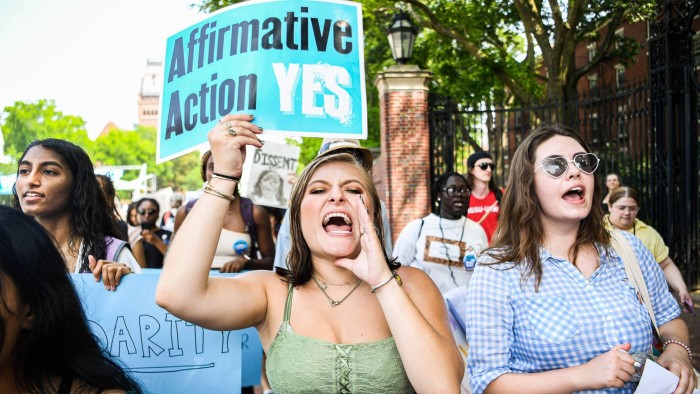Law firms feel chill from affirmative action ruling

Roula Khalaf, Editor of the FT, selects her favourite stories in this weekly newsletter.
If the Supreme Court ruling in June against affirmative action at US universities left law firms wondering how it will affect their diversity goals, Sarah Zearfoss is in a position to offer advice. As senior assistant dean at the University of Michigan Law School, she faced a similar predicament back in 2006 when the state prohibited the use of race as a consideration in admission decisions.
The ban’s effect was marked: enrolment of black, Latino and Native American students almost halved from 17 per cent of the intake in 2005 to 9 per cent by 2008. The number of Asian American students also dropped. “The word plummet is not too dramatic to use,” says Zearfoss. “We stayed at pretty low levels for a few years.”
This year, racial minority groups represent 20 per cent of the freshman class. This is in part, says Zearfoss, because demographic shifts have created a bigger pool of non-white candidates. But, in addition: “We got better at an administrative process that was race-blind.”
Still, many in the legal sector worry how the Supreme Court decision will affect their diversity strategies.
In bringing the case before the Supreme Court, Students for Fair Admissions, a lobby group that challenges affirmative action in school enrolment, argued that considering race in admissions in colleges benefited black and Hispanic students to the detriment of Asian Americans and others.
In a report published this month, US legal sector analyst Leopard Solutions said 64 per cent of diversity professionals at law firms expect the decision to make their job harder. Almost a quarter said they thought the ruling might alter their firm’s goals on diversity, equity, and inclusion (DEI).
While law firms are not directly affected by the Supreme Court decision, many have watched with dismay as, following the ruling, lawsuits have challenged the legality of diversity programmes, including fellowships at Perkins Coie and Morrison Foerster.
“There’s been a lot of activity on [the] lawsuit side of this,” says Valecia McDowell, co-head of a practice at Moore & Van Allen, whose work includes conducting risk management and civil rights and racial equity assessments. “For those professionals who practise in that space — and there’s not many of us — our phones are ringing off the hook.”
Legal threats aside, attacks on “woke capitalism” by Republican politicians in some US states are also having a chilling effect on diversity programmes in businesses, including law firms, says Aaron Taylor, executive director of the AccessLex Center for Legal Education Excellence, which works to increase access to law schools for minority groups.
“You have to respond to a letter from the attorney-general or put out a press release to counter what the governor is saying,” he says. “It increases the cost, even if the politicians don’t have a legal leg to stand on.”
None of this is good news for those who believe the legal sector has always lagged behind others in advancing workforce diversity. Taylor argues that law firms were already paying insufficient attention to providing outreach and opportunities to under-represented groups of people.
Nor are trends improving. Leopard Solutions says that, between 2022 and 2023, promotions of ethnically diverse attorneys fell from 19 per cent to 17 per cent.
But experience has taught Zearfoss that the legal sector — whether law schools or firms — still has plenty of room for manoeuvre, even in the face of legal challenges and conservative backlashes.
Michigan Law, for example, increased the number of essays students could submit as part of their college application, which Zearfoss says “allowed people to tell their stories more fully”. It also started working more closely with undergraduate institutions and minority pipeline programmes to identify diverse cohorts of students.
Zearfoss says strategies ranged from “hitting the pavement” in order to meet potential students in person to introducing anti-bias training for staff, publishing more information about the application process, and writing a blog. “We were looking for opportunities to make connections,” she explains.
Firms, too, can continue supporting employees with diverse backgrounds. For instance, Morrison Foerster’s initiatives include affinity groups and mentorship and sponsorship programmes.
The New York Bar Association has launched a task force to advance diversity in law firms. Co-chaired by Jeh Johnson, a partner at Paul Weiss, and Brad Karp, the firm’s chair, it will provide guidance on the implications of the Supreme Court ruling for colleges, law firms, and other organisations.
McDowell stresses the need to strike a balance in designing DEI initiatives that take into account new legal constraints and the views of conservative lawmakers while meeting the legal duty to prevent workplace discrimination.
Taylor agrees. “We talk a lot about the risk associated with maintaining DEI programmes within law firms. But we don’t talk enough about the risk of getting rid of them,” he says. As well as legal pitfalls, he points to low staff morale and difficulties in retaining talent.
Most importantly, he argues, there has to be a fundamental shift in mindset. “Law firms can do more in terms of how they define merit in their application processes,” he says. “If that is the outcome [of the Supreme Court decision], then there is a silver lining for this case.”

Comments